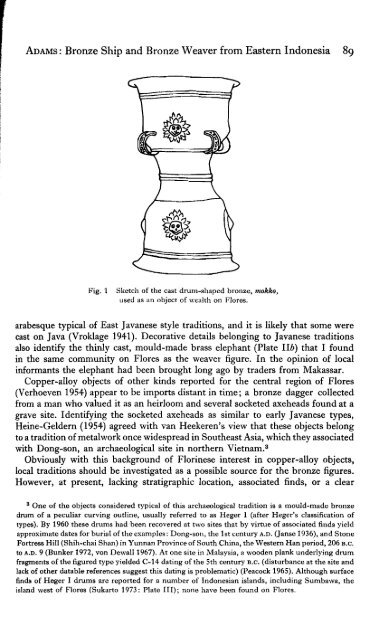A "Forgotten" Bronze Ship and a Recently ... - ScholarSpace
A "Forgotten" Bronze Ship and a Recently ... - ScholarSpace
A "Forgotten" Bronze Ship and a Recently ... - ScholarSpace
Create successful ePaper yourself
Turn your PDF publications into a flip-book with our unique Google optimized e-Paper software.
ADAMS: <strong>Bronze</strong> <strong>Ship</strong> <strong>and</strong> <strong>Bronze</strong> vVeaver from Eastern Indonesia 89<br />
Fig. 1 Sketch of the cast drum-shaped bronze, mokko,<br />
used as an object of wealth on Flores.<br />
arabesque typical of East Javanese style traditions, <strong>and</strong> it is likely that some were<br />
cast on Java (Vroklage 1941). Decorative details belonging to Javanese traditions<br />
also identify the thinly cast, mould-made brass elephant (Plate lIb) that I found<br />
in the same community on Flores as the weaver figure. In the opinion of local<br />
informants the elephant had been brought long ago by traders from Makassar.<br />
Copper-alloy objects of other kinds reported for the central region of Flores<br />
(Verhoeven 1954) appear to be imports distant in time; a bronze dagger collected<br />
from a man who valued it as an heirloom <strong>and</strong> several socketed axeheads found at a<br />
grave site. Identifying the socketed axeheads as similar to early Javanese types,<br />
Heine-Geldern (1954) agreed with van Heekeren's view that these objects belong<br />
to a tradition ofmetalwork once widespread in Southeast Asia, which they associated<br />
with Dong-son, an archaeological site in northern Vietnam. 3<br />
Obviously with this background of Florinese interest in copper-alloy objects,<br />
local traditions should be investigated as a possible source for the bronze figures.<br />
However, at present, lacking stratigraphic location, associated finds, or a clear<br />
3 One of the objects considered typical of this archaeological tradition is a mould-made bronze<br />
drum of a peculiar curving outline, usually referred to as Heger 1 (after Heger's classification of<br />
types). By 1960 these drums had been recovered at two sites that by virtue of associated finds yield<br />
approximate dates for burial of the examples: Dong-son, the 1st century A.D. (Janse 1936), <strong>and</strong> Stone<br />
Fortress Hill (Shih-chai Shan) in Yunnan Province of South China, the Western Han period, 206 B.C.<br />
to A.D. 9 (Bunker 1972, von Dewall 1967). At one site in Malaysia, a wooden plank underlying drum<br />
fragments of the figured type yielded C-14 dating of the 5th century B.C. (disturbance at the site <strong>and</strong><br />
lack of other datable references suggest this dating is problematic) (Peacock 1965). Although surface<br />
finds of Heger I drums are reported for a number of Indonesian isl<strong>and</strong>s, including Sumbawa, the<br />
isl<strong>and</strong> west of Flores (Sukarto 1973: Plate III); none have been found on Flores.
















